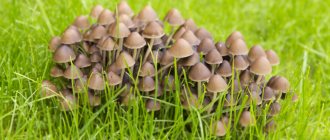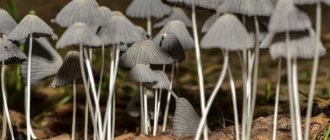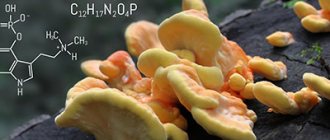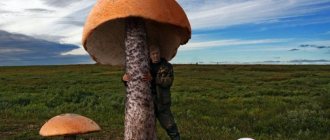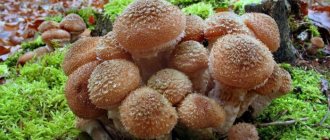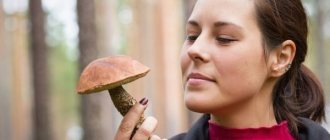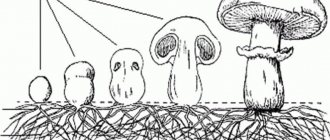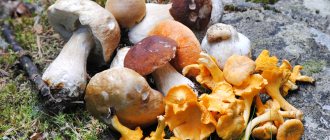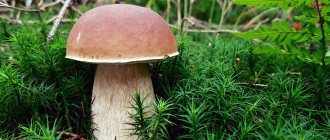Content:
- Should you beware of mushroom hallucinogens?
- Characteristic
- Features of use
- Psilocybin mushroom: effect on the body
- Risks
Psychotropic drugs can be synthesized and natural - they are united by the presence of chemical compounds that affect a person’s psycho-emotional reactions. Due to the same effect of psilocybin mushrooms, they have become popular among individuals wishing to “expand their consciousness.” What is this “dope”? Are the consequences of being “infatuated” with it critical?
Where does Psilocybe semilanceolata grow?
You can meet a dangerous forest inhabitant in a certain area:
- in fields prepared for walking animals (pastures);
- on meadow infertile soils;
- among the grass in forest clearings;
- on swampy, elevated hummocks;
- in wet ground.
The mushroom loves fields where cattle graze. Especially if the field is no longer visited by animals. There are many such places of growth throughout Russia; the Moscow region is no exception.
Should you beware of mushroom hallucinogens?
The psychedelic effect of this natural psychotropic is caused by specific biologically active compounds. They lead to changes:
- emotions;
- psyche;
- intelligence;
- memory.
Fans of psychotropics themselves claim that such properties of the drug are unexpressed. Meanwhile, you should beware of hallucinogens - the reasons are as follows:
- there is no exact evidence that they do not have a destructive effect on thinking and the psycho-emotional sphere;
- The amount of psychotropic at which there is a risk of overdose with critical consequences has not yet been established experimentally.
On the legality of deliberate collection of hallucinogenic mushrooms
In Russia, responsibility is provided for the collection and distribution of hallucinogenic forest representatives. A ban is imposed on all actions with mushrooms:
- collection in any forest area;
- growing on your own plots of land;
- distribution for consumption in raw and prepared form;
- sale of powders and other formulations of hallucinogenic species;
- exchange for any prohibited and permitted medicines;
- distribution of growing material;
- advertising of positive properties.
The law provides for various penalties for illegal acts of this type:
- fines;
- administrative punishment;
- criminal liability.
Legislation studies the scale and severity of actions. The singularity or systematic nature of the measures and against whom they were directed are taken into account. One punishment if it was all done for personal use, another when it caused violations of someone else’s health.
The volume of hallucinogenic material has implications for sentencing:
- 5 g – large delivery. Administrative violation;
- 20 g – extra large. Criminal liability.
The status of hallucinogenic mushrooms is established for Psilocybe semilanceolata by a list of plants that are controlled by the state. There is no need to look for it there. The name itself suggests that mushrooms contain psilocybin, which is on a special line among narcotic and psychotropic substances.
Characteristic
A large number of psilocybin mushrooms have been identified that can provoke narcotic effects. Their severity depends on a number of factors. The most significant:
- plant variety;
- concentration of psychotropic compounds;
- growth conditions - humidity, light, temperature, soil characteristics;
- degree of maturity of the fruiting body.
The narcotic effect is achieved due to the influence of substances such as:
- psilocinogen - it is found in all representatives of such hallucinogens;
- psilocin - found only in some of their varieties, but can also be formed during the metabolism of psilocybin in tissues.
The effect of these psychotropics on a person also depends on his individual characteristics. The most significant are:
- activity of tissue enzyme systems;
- liver diseases;
- use of other types of psychoactive drugs - drugs, alcohol, nicotine.
Other types of biologically active substances have been identified in psilocybin mushrooms: beocystin, eruginascin, phenylethylamine, and lysergic acid. Even analogues of serotonin have been discovered - the “happiness hormone”, thanks to which a person experiences joy, satisfaction and similar positive feelings. But the influence of these substances is not as pronounced as that of psilocybin and psilocin.
Psilocybin and its derivatives can be considered plant analogs of neurotransmitters that regulate the activity of nerve structures in the human body. They:
- have a similar structure;
- bind to the same receptors;
- cause the same effects.
These active substances have a negative effect on:
- in smaller quantities - on serotonin receptors;
- mostly on the receptors of norepinephrine (a neurotransmitter that is responsible for the speed of transmission of nerve impulses along neurons and interneuron connections).
External differences
Anyone who wants to experience the thrill should know how to distinguish a psilocybin mushroom from a toadstool. The price of a mistake is life. And although at first glance they look similar, there are noticeable differences between them.
Hallucinogenic plants turn blue when their fruiting body is damaged - this is the most identifiable sign. The cap is small, conical in shape with a tubercle at the top. The color can range from white to dark brown; when broken, the flesh inside is cream-colored.
The poisonous mushroom has a large, wide cap with a diameter of about 5 cm, smooth, slightly elongated or hemispherical in shape. When damaged, the pulp does not change color and remains white. It has a slight odor, the leg is usually grayish.
You can distinguish mushrooms by smell and taste (although doing the latter is strictly prohibited and deadly). The toadstool has a light, almost imperceptible odor, and the psilocybin plant has a characteristic smell and taste.
The legs are also different:
- in a poisonous mushroom it is dense, thickening towards the bottom;
- in its hallucinogenic counterpart, it is often curved, long and thin, but at the same time elastic and durable.
Of course, you can distinguish these mushrooms, but if you or your loved one has to do this, then this indicates problems. You can always go to a drug treatment clinic to get professional advice or sign up for treatment. There are no unsolvable problems.
Features of use
To produce a psychogenic effect, psilocybin mushrooms are taken orally. They are used:
- fresh or dried;
- one variety or as a mixture of different species.
They also try to use this “dope” together with other drugs. But such experiments are fraught with danger, since the risk of critical violations on the part of vital systems is much higher:
- cardiovascular;
- respiratory.
Use of Psilocybe semilanceolata in medicine
The substance contained in mushrooms cannot be isolated in a home laboratory. That is why doctors warn that such experiments can kill a person. But the impact must be constant, that is, a person must systematically destroy his body. Western pharmaceutical production uses the substance to treat various pathologies. Used as a neurotropic drug. It is included in a complex of drugs against:
- memory impairment;
- increased anxiety;
- paranoia;
- schizophrenia;
- migraine.
Any drug must be prescribed by a doctor. You shouldn’t start cooking with poisonous mushrooms yourself; you can cause dangerous complications and unforeseen reactions of the body.
Psilocybin mushroom: effect on the body
With moderate use of the described potion, the following occur:
- euphoria - a feeling of boundless joy, a desire to have fun and rejoice;
- emotional upsurge;
- improved mood;
- hallucinations.
The functioning of the sense organs is disrupted - visual, auditory and tactile stimuli are perceived differently. Thus, ordinary sounds seem unpleasant. Taste and smell are often distorted.
It’s as if a drug addict finds himself in another world; he has:
- spatial-temporal sensations change;
- thinking processes are disrupted;
- libido increases;
- internal barriers disappear.
A person's principles change:
- life values appear in a different form;
- the norms of legality and morality are perceived differently, but at the same time there is a feeling of belonging to something spiritual.
While under the influence of psilocybin mushrooms, the addict expects pleasant emotions to arise. But instead of them, anger, irritability, despondency, and unmotivated fear may appear (it seems that something bad is about to happen). Particularly susceptible individuals experience panic attacks and suicidal intentions.
This “potion” also causes malfunctions in other organs and systems. The most typical:
- hyperthermia (increased body temperature) of varying severity;
- mydriasis (dilation of pupils regardless of light intensity);
- increased and increased heart rate;
- nausea;
- vomit;
- incoordination of movements;
- incoherence of speech.
Risks
When using psilocybin mushrooms, mental dependence develops - the addict wants to be in a state of euphoria, so he is in no hurry to give up the “potion.” The existence of physical addiction (the inability of organs and tissues to function normally without this type of “dope”) has not been confirmed. Also, the occurrence of withdrawal symptoms has not been proven.
Thrill-seekers, trying to get this psychotropic, go on a “silent hunt”, but they can confuse a poisonous and psilocybin mushroom - the effect on the body when eating toadstools and fly agarics will manifest itself as symptoms of poisoning. This:
- pronounced pallor of the skin and visible mucous membranes;
- severe nausea;
- profuse (severe) vomiting;
- repeated diarrhea.
Poisoning can lead to disruption of the cardiovascular system. Increased heart rate, a significant decrease in blood pressure, and heart rhythm disturbances are observed. In severe cases, coma (loss of consciousness) and death occur.
How to identify a mushroom and distinguish it from similar species
When going to the forest, mushroom pickers prepare. But more often this preparation includes the appearance of a mushroom picker. Experienced foresters advise not to forget about theoretical training and knowledge. This approach will avoid mistakes. Inedible and dangerous inhabitants of the forest will remain untouched and will never appear in the basket. What distinguishes the poisonous guest of the forests, the psilocybin species:
- the hat is thin and ugly;
- the interior is lamellar;
- the surface of the head varies depending on the place of growth: dry, wet.
- the plates are firmly connected to the leg, almost united;
- spores are similar in shape to grains;
- The structure of the leg is cartilaginous.
The mushroom is unattractive and looks more like other toadstools. It always grows in whole families, stretching one above the other.
